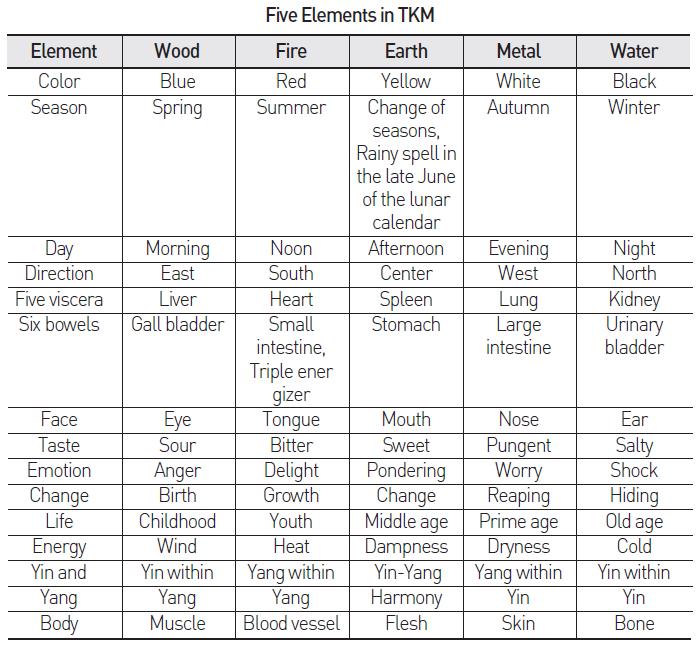Written by Jeonghwa Lee, Choonjae Lee, Published by Korea Institute of Oriental Medicine
A. Yin and Yang
1. Basic Concept of Yin and Yang
Yin symbolizes the negative and passive aspects such as darkness, earth, moon, and nil whereas yang represents the positive and active aspects like brightness, sky and sun. Yin and yang are two opposing cosmic forces which are present in all objects and phenomena in the natural world as in the cases of moon and sun, top and down, in and out, summer and winter, north and south, man and woman, hot and cold, static and dynamic, and fast and slow. The concept of yin and yang is used to explain natural phenomena but it also constitutes the basis of TKM theory.
2. Basic Changes in Yin and Yang
- The mutual opposition of yin and yang: All objects and phenomena have opposing aspects of yin and yang. There
are always two opposing objects, or an object has opposing traits of yin and yang in itself. - The mutual dependence of yin and yang: Since yin and yang are interdependent, one cannot be separated from the
other and cannot exist alone. In other words, one cannot exist alone because the existence of the other is the precondition for its own existence. - The mutual waxing and waning of yin and yang: Yin and yang are non-static. Rather, they always change and are in constant movement. Yin and yang consume each other, but at the same time they generate each other. When yin grows stronger, yang is consumed and weakened. When yang grows stronger, yin becomes weakened.
- The mutual conversion of yin and yang: When changes in yin and yang reach a certain point, yin transforms into
yang, and yang into yin. - The infinite divisibility of yin and yang: Yin and yang can always be divided. According to this division principle, all
the existing matter in the universe can be divided into smaller matters until they become the smallest particles, which can be again divided into yin and yang. This is the principle of endless division of yin and yang.
3. Application of Yin and Yang in TKM
The theory of yin and yang is the most fundamental concept of TKM. TKM categorizes all the parts and functions of the human body into yin and yang, and applies this categorization to pathology, diagnosis and treatment. Intangible spirit is yang while tangible body is yin. The six bowels, which become active if necessary and go through a lot of changes, fall under yang whereas the five viscera, which are constantly on the move and go through fewer changes, fall under yin. Active and formless qi is yang, whereas less active and tangible blood is yin. The meridians and collaterals belonging to six bowels are yang and those belonging to five viscera are yin. In TKM, pathology, diagnosis, and treatment are also classified as yin or yang.
B. Five Phases / Elements
1. Basic Concept of Five Elements
All the matters and energy in the universe can be classified into five elements: wood, fire, earth, metal and water, which, to be more accurate, represent wood energy, fire energy, earth energy, metal energy and water energy, respectively.
- Wood: Wood energy is best represented by wood. Wood means the powerful and outward movement of young shoots bursting through hard ground. Wood corresponds to spring among the four seasons.
- Fire: The Chinese letter fire comes from the image of blazing fire. Fire energy flares upwards. Since it goes upward and disperses, fire energy strengthens the dispersion function. It corresponds to summer among the four seasons.
- Earth: The law of the universe dictates that matter grows and breaks up into the processes of wood and fire. Earth stops the matter from growing further. The matter then goes through maturity and storage in the processes of metal and water. Therefore earth represents the middle, which can change into either yin or yang. There are two theories regarding which season earth corresponds to. The first is concerned with the period when the change of yin and yang takes place. That is, change of seasons from spring to summer, summer to autumn, autumn to winter, and winter to spring. The second is concerned with the rainy period in the late June of the lunar calendar, the humid period between summer and autumn.
- Metal: Metal has solid and cold attributes and corresponds to autumn. When autumn comes, flamboyant and colorful trees shed their leaves and bear fruits, their bark becomes harder. This means the end of outer growth and the beginning of inner maturity. Metal signifies that things have come to fruition.
- Water: Water corresponds to winter. When winter comes, snow falls and ice freezes. Both snow and ice are made of water. Water converges at the lowest place and covers all the things beneath it just as snow blankets all the objects in the world. Water, like frozen ice in winter, stores everything and prepares for the coming spring.
In summary, the five elements are composed of wood (generation), fire (growth), earth (mediating generation, growth, convergence, and storage), metal (convergence), and water (storage).
2. The Interrelationships of Five Phases / Elements
- (Mutual) Engendering: Here, mutual means that it involves both elements, and engendering indicates generation or promotion. The sequences of mutual engendering are: wood engenders fire, fire engenders earth, earth engenders metal, metal engenders water, and water engenders wood. They circulate. In the mutual engender,
Wood engenders fire: Wood means generation, a prerequisite for growth.
Fire engenders earth: Fire means growth, a prerequisite for change.
Earth engenders metal: Earth means change, a prerequisite for convergence.
Metal engenders water: Metal means convergence, a prerequisite for storage.
Water engenders wood: Water means storage, a prerequisite for generation.
For example, if the five elements of wood, fire, earth, metal and water are applied
to the four seasons, mutual engendering would mean the cycle of the seasons in
which spring is followed by summer, summer is followed by a rainy spell in the
late June of the lunar calendar, the rainy spell is followed by autumn, autumn is
followed by winter, and winter is followed by spring.
- (Mutual) Restraining: Mutual restraining means restriction and constraint. That is, it means the restricting and constraining relationships between the five elements. In short, the five elements restrain and promote one another.
The sequences of mutual restraining among the five elements are: wood restrains earth, earth restrains water, water restrains fire, fire restrains metal and metal restrains wood. They circulate.
The relationship of mutual restraining can be compared with the development of a tree. When a tree bears fruit, its branches wither (Metal restrains wood). When leaves flourish, fruits are immature (Fire restrains metal).
When it is winter, leaves fall (Water restrains fire). When boughs grow fast, there are less flowers blooming (Wood restrains earth). When flowers bloom, the growth of roots is restrained (Earth restrains water).
The mutual restraining can also be compared with the four seasons. As spring and summer come, it gets hotter and hotter until one day when it suddenly cools off. In winter, freezing cold seems to go on forever, but then one day we realize the ice is thawing. If the natural world has only mutual engendering, the summer will get hotter while the winter gets colder.
Thanks to mutual restraining, however, the summer at its peak is restrained by invisible winter energy. The opposite is also true. The winter at its peak is held back by invisible hot summer energy.
3. Application of the Five Elements / Phases in TKM

The universe can be classified not only into yin and yang but also into five elements, as shown in the table below.
As shown in the table above, the theory of the five elements, like the principle of yin and yang, is applied to TKM in many areas such as the structure of human body, physiological activities, pathological changes, diagnosis, and treatment.

































